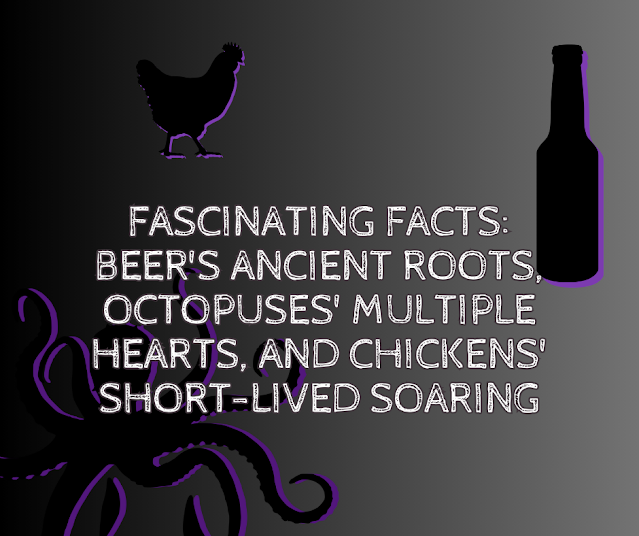Fascinating Facts: Beer's Ancient Roots, Octopuses' Multiple Hearts, and Chickens' Short-lived Soaring
1. Octopuses have three hearts.
These fascinating creatures are known for their unique circulatory system.
Out of the three hearts, one is a systemic heart, and the other two are branchial hearts. The systemic heart is responsible for pumping oxygenated blood throughout the octopus's body. It receives the blood from the gills after it has been oxygenated and distributes it to all the organs.
On the other hand, each branchial heart is situated near each of the octopus's gills. The branchial hearts are responsible for pumping deoxygenated blood to the gills for oxygenation. Once oxygenated, the blood is then directed to the systemic heart for distribution.
The presence of three hearts enables octopuses to have a highly efficient circulatory system and aids in their remarkable ability to adapt to various environments and engage in complex behaviors. It is one of the many incredible adaptations that contribute to the octopus's overall exceptional biology.
2. The world's oldest known recipe is for beer.
The world's oldest known recipe is indeed for beer and it dates back approximately 4,000 years. The recipe was discovered on a Sumerian tablet in Mesopotamia (modern-day Iraq) dating back to around 1800 BCE.
The tablet contains a hymn to the Sumerian goddess of beer, Ninkasi, which also serves as a recipe for making beer. This is why it is considered the oldest known recipe in the world.
The recipe describes the process of brewing beer, listing the ingredients and the specific steps involved. It includes instructions on how to soak barley in water, bread-making techniques, and even the use of fermentation in the brewing process. The tablet also mentions the role of the goddess Ninkasi in the creation of beer, showing the cultural and religious significance of beer in the ancient Mesopotamian society.
This discovery provides fascinating insights into the ancient civilization's knowledge of brewing and their appreciation for beer as an essential and valued beverage. It demonstrates that beer has a long history of being enjoyed by humans, predating many other recorded recipes.
3. The longest recorded flight of a chicken is 13 seconds.
Domestic chickens, which are typically heavier due to selective breeding for meat production, are not known for their long-distance flight abilities. However, lighter bird breeds, such as certain game birds or wild pheasants, are generally more capable of sustained flight.
The longest recorded time a chicken has been observed flying continuously is 13 seconds. This means that during that observation, the chicken managed to stay airborne without touching the ground for 13 seconds. It is important to note that this is an exception rather than the norm for chickens.
Additionally, the furthest recorded flight of a chicken covers a distance of 301.5 feet. This means that a chicken managed to travel quite a substantial distance through the air during its flight. However, it should be noted that this flight distance is an extreme case and not what one would typically expect from a domestic chicken.
In summary, while chickens are not known for their impressive flight abilities, they are capable of brief periods of flight, with the longest recorded flight being 13 seconds. The furthest recorded flight of a chicken covered 301.5 feet.


Comments
Post a Comment